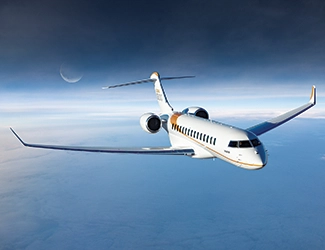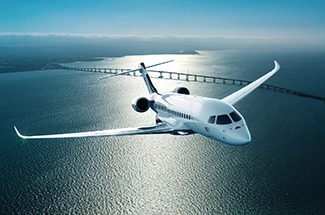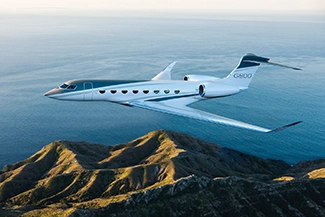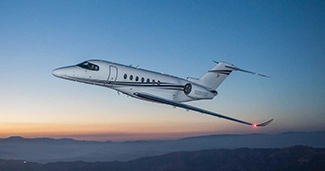Long-range business jets
Airframers offer speed and luxury for deep-pocketed travelers.
By Owen Davies
Contributing Writer
It has been a busy and prosperous time for corporate jet makers since we last looked at long-range jets (Pro Pilot, Mar 2024, p 30). Sales are up, backlogs are growing, and it looks like this trend could continue well into next year. For executive airframers, happy days are here again.
Yet not all is well in the market for ocean-hopping bizjets. The post-Covid-19 recession put a crimp in corporate jet sales, and the resulting disruption of aircraft supply chains means that replacement parts are scarce or unavailable for many models. So are parts and assemblies for some new aircraft. The Dassault Falcon line has suffered more than most from these unmet needs.
An estimated 4000 of the world’s 23,000 business jets in service are long-range models. The most popular aircraft in this segment to date are the Gulfstream G550, with 570 in service, and the Dassault Falcon 900 family, with 529.
This is a remarkably stable market. Gulfstream sells roughly 49% of long- and ultra-long range aircraft by dollar value. Bombardier’s market share is about 25.4%, with Dassault accounting for 9.4%. These numbers reflect the recent popularity of the largest, longest-legged business aircraft, which carry the biggest price tags.
These figures add up to roughly 101% owing to roundover errors. They also hint at how many jets Cessna and Embraer sell in this category. Those companies are much more successful in the market for smaller, shorter-range business aircraft.

Bombardier
The company’s Global aircraft share amenities that make for smooth, comfortable rides, such as HEPA-filtered air, supple smooth flex wings to damp turbulence, the Soleil lighting system to reduce jet lag, and patented Nuage seats to make for a cushy ride. They also operate at up to 51,000 ft, leaving most weather far below. Choosing among Global models comes down to range, speed, and price.
If Global aircraft are Bombardier’s long-range, high-capacity luxury vehicles, the Challengers are more like family vans, offering comfortable transportation at slower speeds. They’re designed for shorter ranges and fewer people, with maximum reliability and relatively low operating costs.
Global 8000. With FAA certification expected early this year, Bombardier’s flagship is an airliner scaled for 4 crew/8–19 pax. With a high-speed cruise of 595 kts, and maximum mach operating speed (MMO) of M 0.94, it is the fastest civilian aircraft since the Concorde. It can circle the globe in only 2 hops. A year ago, only a converted heavy could do that. Expected price is $78 million.
Global 7500. With a range of 7700 nm and a max speed of M 0.925, upgradeable to M 0.94, the Global 7500 broke 50 route records in its first 50 weeks. The aircraft offers a full-sized kitchen, a dedicated crew suite, and 4 living zones for passengers. At $80 million per unit, 200 had been delivered by mid-December 2024.
Global 6500. Flying from New York to Dubai, London to Hong Kong, or New York to London and back? The Global 6500 will make it with plenty of fuel to spare. A spacious 3-zone cabin, a stand-up shower in the en suite, and Rolls-Royce Pearl 15 engines provide comfortable, efficient travel for up to 4/17. It’s priced at $58 million.
Global 5500. Continuing Bombardier’s theme of comfortable, efficient travel, the Global 6500 can deliver 3/10–16 5900 nm at 487 kts long-range cruise (LRC), or 504 kts high-speed cruise (HSC). A mere $47.9 million goes a long way these days.
Challenger 650. Carrying 6–12 pax up to 4000 nm, the Challenger 650 offers 529 kts typical LRC and 542 kts HSC. Direct operating costs (DOCs) for the $33.3-million aircraft are around $3385 per hour – low for this category of jet. Several operators report high dispatch reliability.
Challenger 3500. With a 3400-nm range, the smallest Bombardier carries 8–10 pax at 534 kts typical speed, and 547 kts HSC. Jetcraft rated the Challenger 3500 as having the most technologically advanced cabin in its class, with outstanding field performance and steep-approach capabilities. With a current price of $27.2 million, at least 100 Challenger 3500s had been sold by the end of 2024.

Dassault Falcon
Dassault’s Rafale fighter has a reputation for speed and agility. And this well-earned reputation rubs off on the company’s business jets. Customers expect the Falcon line to be fast and uncommonly nimble for their market.
Falcon 10X. With space for up to 21 pax and a taller, wider cabin than its competitors, the 10X offers a range of 7500 nm, LRC of 488 kts and HSC of 531 kts. At $75 million, it offers high fuel efficiency thanks to a thin wing and bespoke Rolls-Royce Pearl 10X engines. Unfortunately, you can’t have one yet. Severe supply chain issues have pushed deliveries from 2025 to 2027.
Falcon 8X. With 3 Pratt & Whitney Canada (P&WC) engines, a bizjet configuration unique to Dassault Falcon, the 8X is exempt from ETOPS regulations, allowing greater operational flexibility within its 6450-nm range. It carries 3/12–19 at 533 kts LRC or 600 kts HSC. If you need to fly from New York to Beijing or Singapore to London in a single hop, this could be your mount for only $65.2 million.
Falcon 6X. Carrying 3/12–16 up to 5500 nm at 533 kts LRC, the Falcon 6X has an HSC of 567 kts. Takeoff distance is 5115 ft, but at MSL a 2-hour flight can be off the ground in 3000 ft. HSC is 567 kts. A wide cabin and low noise levels make for a comfortable ride. The price is $55 million.
Falcon 900LX. Dassault’s second 3-engine model carries 2/8–14 up to 4750 nm at 459 kts LRC. HSC is 474 kts. This $45-million aircraft takes off in 5360 ft. Amenities include a full kitchen, double club seating, digital surround sound, and charging stations throughout.
Falcon 2000LXS. With a range of 4000 nm, this $37-million bird carries 2/8–10 at 437 kts LRC or 483 kts HSC. A 4675-ft balanced field length (BFL) makes it suitable for many smaller airports, while a variable operating cost of $1500 to $1800 per hour makes it very suitable for smaller budgets.

Embraer
Unlike other companies that build airliners, Embraer offers 4 purpose-built bizjets. Two have ranges above our 3000-nm limit.
Praetor 600 can carry 2/8–12 up to 3719 nm at 536 kts HSC, or up to 4018 nm at 466 kts LRC. That’s at least 400 nm further than other super-midsize executive jets. In its DNA Design configuration, the $22.25-million aircraft offers 8 seats that can be converted to 4 beds. Comfort is a major selling point for the Praetor 600.
Praetor 500. Certified for single-pilot operations, this 2/7–9 jet offers a range of 3349 nm at an LRC of 438 kts. HSC is 466 kts. A takeoff distance of 4222 ft lets it operate from shorter fields than its competitors. A 6-ft-tall flat floor cabin, noise reduction, and luxury seating configurations make for comfortable travel from New York to Los Angeles, Los Angeles to Hawaii, or New York to Dublin.
Gulfstream

Gulfstream is known for long range and high speed, technological innovation, and devotion to craftsmanship and luxury. It also benefits from its global network of more than 60 service facilities and 15 parts distribution centers, and from generous funding by parent company General Dynamics.
From the G800 down to the G500, all models offer 567 kts LRC and 600 kts HSC. Down to the G400, max operating altitude is 51,000 ft.
G800. With a go-anywhere range of 8000 nm, it offers 4/12–19 capacity and up to 4 living areas. In some layouts, it can sleep up to 10 pax. Add the quietest cabin in business aviation, a cabin altitude of 2916 ft, 100% fresh air every few minutes, and an expected price of $75 million, and it should be an attractive proposition for the ultra-high-net-worth crowd.
G700. First deliveries occurred in April 2024, 2 years behind schedule, mostly due to regulatory changes and internal issues at FAA. An estimated 30 G700s had reached customers by January 2025. With room for 3/10–19, it has the largest cabin in the Gulfstream line, with up to 5 living areas – 4 of them with a dedicated crew rest area. It sleeps up to 13 in some configurations. G700’s range is 7750 nm at LRC, and 6650 nm at HSC. Price is $79 million.
G650/G650ER. The G650ER has a max range of 7500 nm, compared to the G650’s 7000 nm. Either model can carry 4/10–19 from New York to Tokyo or Los Angeles to Sydney. With up to 4 living areas, both models can sleep up to 10 pax. Luxurious cabins with Mid-Century Modern touches offer wide appeal at base prices around $65 million for the G650 and $70 million for the G650ER.
G600. Traveling from New York to Dubai or San Francisco to London? The G600 will get you there with a few nautical miles to spare. Seating 4/10–19, it can sleep up to 10 pax in some configurations. With a cabin altitude of 3500 ft, fresh air every 2 minutes, and one of the industry’s quietest cabins, this $58.8-million aircraft offers long-range comfort at variable expenses of approx $6374/hour.
G500. With a range of 5300 nm at LRC and a max cruise of 616 kts, the G500 will carry 3/10–19 from Los Angeles to Tokyo or San Francisco to Hong Kong. A typical configuration seats 10, with a berthable divan in the aft cabin. High-speed Wi-Fi, multiple monitors, and a passenger-controlled cabin management system make for a pleasant journey in this $45-million aircraft.
G400. At a base price of $34.5 million, the 3/9–12 G400 offers 4200-nm range at an LRC of 488 kts, or an HSC of 516 kts. Standard, but highly customizable, layouts are available. A cabin altitude of just over 3000 ft helps keep pax comfortable during long flights.

G280. Gulfstream’s smallest airplane is still a super-midsize jet. It carries 2/8–10 up to 3600 nm at 470 kts LRC or delivers an HSC of 566 kts at altitudes up to 45,000 ft. Comfort features include adjustable executive seating, a full galley, a lavatory, and a cabin altitude of 4800 ft. With a base price of only $25 million, it may be the most economical transportation from Houston to Honolulu or Reykjavík.
Textron
Citation Longitude. Going from New York to Los Angeles or the UK? The Citation Longitude’s 3500-nm range will get 8–12 pax there in comfort. LRC is 457 kts. HSC is 483 kts. This $27.99-million aircraft’s chief claim to fame is economy.
Cessna says the Citation Longitude will save up to 18.7% in operating costs over 5 years of ownership, compared with other super-midsize business jets.
 Owen Davies is a veteran freelance writer specializing in technology. He has been a futurist at Forecasting International and TechCast Global.
Owen Davies is a veteran freelance writer specializing in technology. He has been a futurist at Forecasting International and TechCast Global.